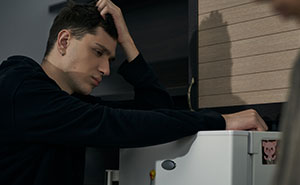
According To Experts, Middle-Class Americans May Soon Find These 22 Things Unaffordable
Interview With ExpertLast weekend, when I went grocery shopping and had to part with a chunk of money, it suddenly hit me how expensive everything is getting. I mean, you work your back off every day to earn money, and then you lose half of it purchasing regular things. Sounds unfair, doesn’t it?
Nobody bears the brunt of it more than the middle class, because regular things are getting unaffordable for them in the US, as revealed by Yahoo Finance and Epic Economist. The regular things that make up this pricey list might even shock you, so just scroll down and check it out!
More info: YouTube
This post may include affiliate links.
Miss A Paycheck
 Between 1979 and 2024, productivity in the U.S. soared by 80.9%, while hourly pay grew by just 29.4%. This wage stagnation makes it harder for middle-class Americans to keep up with the rising inflation, and missing a paycheck can be disastrous for those who live paycheck-to-paycheck.
Between 1979 and 2024, productivity in the U.S. soared by 80.9%, while hourly pay grew by just 29.4%. This wage stagnation makes it harder for middle-class Americans to keep up with the rising inflation, and missing a paycheck can be disastrous for those who live paycheck-to-paycheck.
When I was 16 in 2008, I got my first job for $17 an hour. I’m now 32 and recently laid off so I had to take whatever I could get to pay the bills - for $18 an hour. It’s so weird to be making an almost identical wage to my teenage years and barely able to afford anything besides my bills. I’m using food banks now, but I used to be able to survive just fine on $1 less an hour. I have no extra expenses either, just me and an old beater car that costs $99 insurance a month.
Retirement Savings
 Retirement is increasingly becoming a luxury many American workers cannot afford. With rising housing costs and medical expenses, millions of older Americans can’t stop working. The sad truth is that only 40 percent of men who are regularly saving for retirement believe they are saving enough. Unfortunately, for women, the number is only 30 percent.
Retirement is increasingly becoming a luxury many American workers cannot afford. With rising housing costs and medical expenses, millions of older Americans can’t stop working. The sad truth is that only 40 percent of men who are regularly saving for retirement believe they are saving enough. Unfortunately, for women, the number is only 30 percent.
Healthcare
 The United States has one of the highest costs of healthcare in the world. In 2022, U.S. healthcare spending reached $4.5 trillion, which averages to $13,493 per person. Moreover, 26 million Americans, or 8 percent of the U.S. population, lacked health insurance in 2023. This further adds to an unhealthy lifestyle suffered by these people
The United States has one of the highest costs of healthcare in the world. In 2022, U.S. healthcare spending reached $4.5 trillion, which averages to $13,493 per person. Moreover, 26 million Americans, or 8 percent of the U.S. population, lacked health insurance in 2023. This further adds to an unhealthy lifestyle suffered by these people
They should also report the number of Americans that have insurance that doesn't contribute anything until many thousands of dollars are spent. The 8% uninsured stat paints a misleading picture of the real state of things.
As you scroll through the list, you will realize that some of these things are quite essential to lead a healthy and satisfied life for the middle class. To get a deeper understanding of the rising cost of these daily things, Bored Panda got in touch with Madhura, who was a student of economics and also has over 2 years of experience working in the financial sector.
She explained that the increasing unaffordability of goods and services for the middle class in the USA is primarily driven by inflation, wage stagnation, and rising housing costs. Inflation, as per her, has significantly increased the prices of essential goods and services, while wage growth has not kept pace, leading to diminished purchasing power.
“Additionally, housing costs have surged, making it increasingly difficult for middle-class families to afford homes and maintain their standard of living. Tariffs have also led to higher consumer prices as businesses pass on the costs of imported goods to consumers,” Madhura added.
Emergency Savings
 Financial experts generally suggest setting aside three to six months’ worth of your living expenses in an emergency fund. However, nearly 37% of Americans say they couldn’t afford an emergency expense over $400, and shockingly enough, 21% of people have no emergency savings at all.
Financial experts generally suggest setting aside three to six months’ worth of your living expenses in an emergency fund. However, nearly 37% of Americans say they couldn’t afford an emergency expense over $400, and shockingly enough, 21% of people have no emergency savings at all.
amazing that the average joe is expected to have "three to six months’ worth of living expenses in an emergency fund", yet multi-million dollar businesses aren't. As soon as they start losing money they go crying to the gov't for a bailout - which they usually get.
Homeownership And Real Estate
 The average United States home value is $357,469, which increased a whopping 2.5% over the past year. This has also impacted the age of home buyers. The average age of first-time homebuyers has increased to around 33 years, reflecting the challenges younger generations face in affording homes due to rising prices and stagnant wages.
The average United States home value is $357,469, which increased a whopping 2.5% over the past year. This has also impacted the age of home buyers. The average age of first-time homebuyers has increased to around 33 years, reflecting the challenges younger generations face in affording homes due to rising prices and stagnant wages.
Child Care
 While the cost of child care varies depending on several factors, the average cost of child care in the United States was $11,582, in 2023. This is a nearly 250% increase from 1991. Considering wage stagnation and the cost of hospitalization for delivery, younger people are hesitating to have kids.
While the cost of child care varies depending on several factors, the average cost of child care in the United States was $11,582, in 2023. This is a nearly 250% increase from 1991. Considering wage stagnation and the cost of hospitalization for delivery, younger people are hesitating to have kids.
Not only because of the cost of having kids! The state of the world would make me hesitate.
Madhura elaborated that inflation has significantly raised living costs, with essential goods becoming more expensive. Meanwhile, she mentioned, wage growth has not kept pace with inflation.
“Average hourly earnings have decreased when adjusted for inflation, making it increasingly difficult for families to maintain their standard of living. Housing prices have surged, with many areas experiencing increases that outweigh wage growth,” our expert claimed.
Going To The Dentist
 A simple task like maintaining good dental health has become challenging as 80% of Americans delay dental care knowing that it will cost them more in the long term. It might be because of this negligence that the oral health of American working-age adults has not improved over the past 20 years.
A simple task like maintaining good dental health has become challenging as 80% of Americans delay dental care knowing that it will cost them more in the long term. It might be because of this negligence that the oral health of American working-age adults has not improved over the past 20 years.
Doesn't help when high-sugar foods are promoted with multiple flavors and market medias.
Marriage
 Gone are the days when regular people could afford big traditional weddings as the average cost of a wedding in the United States in 2024 was around $33,000, a slight increase from the previous year's $29,000. This spiked cost has not only affected the number of guests getting invited, but the marriage rate has also declined.
Gone are the days when regular people could afford big traditional weddings as the average cost of a wedding in the United States in 2024 was around $33,000, a slight increase from the previous year's $29,000. This spiked cost has not only affected the number of guests getting invited, but the marriage rate has also declined.
New Vehicles
 The average price of a new vehicle in the United States in 2023 was around $47,010, which was about 1.6% higher than in 2022. In addition to the purchase price, other expenses like registration, repairs, and insurance also impact the overall budget. Considering the fact that the average salary in the USA is $68,124 per year, it becomes challenging for middle-class families to own a car.
The average price of a new vehicle in the United States in 2023 was around $47,010, which was about 1.6% higher than in 2022. In addition to the purchase price, other expenses like registration, repairs, and insurance also impact the overall budget. Considering the fact that the average salary in the USA is $68,124 per year, it becomes challenging for middle-class families to own a car.
"Considering the fact that the average salary in the USA is $68,124 per year". Where is this at where the average is that high?
Our expert believes that the growing wealth gap adversely affects the purchasing power of the middle class by concentrating resources among the wealthy while leaving many families struggling to afford basic necessities.
“The wage gap between CEOs and average employees has widened significantly; for instance, CEO compensation has increased dramatically over the years compared to stagnant wages for typical workers. This disparity limits economic mobility and restricts access to resources necessary for investment in education and healthcare,” Madhura noted.
Everyday Expenses
 The everyday expenses like utilities, groceries, travel, etc. also take a hit for the middle-class folk as the inflation keeps rising. The average annual cost of living for a single person is $44,312, which eats up most of their salary, leaving little space for savings.
The everyday expenses like utilities, groceries, travel, etc. also take a hit for the middle-class folk as the inflation keeps rising. The average annual cost of living for a single person is $44,312, which eats up most of their salary, leaving little space for savings.
I definitely make less than that. The only thing that keeps me slightly sane is that I think in '90's income terms. Don't ask, it works.
Eating Healthy Foods
 The cost of eating healthy food averages $1000 to $1200 per month, and as the middle class is unable to afford it, they look for cheaper alternatives, consuming unhealthy food. This leads to an unhealthy lifestyle, which puts people in a vicious cycle of unaffordability of healthcare and good food.
The cost of eating healthy food averages $1000 to $1200 per month, and as the middle class is unable to afford it, they look for cheaper alternatives, consuming unhealthy food. This leads to an unhealthy lifestyle, which puts people in a vicious cycle of unaffordability of healthcare and good food.
Brand Name Items
 The sale of branded items in the US has decreased, particularly luxury goods. There's a shift in consumer behavior as sales of private-label brands have increased owning to the fact that consumers have become more budget-conscious.
The sale of branded items in the US has decreased, particularly luxury goods. There's a shift in consumer behavior as sales of private-label brands have increased owning to the fact that consumers have become more budget-conscious.
Brand-name items are often bought to cater to our personal egos. We think we’re cooler, better people for owning a certain brand of product. We think people will perceive us better for owning those products and we think people are cooler for owning those products too. It’s exhausting brainwashing.
Madhura also raised some major concerns about the lasting consequences that the unaffordability of higher education or healthcare can have on the middle class. “In the USA, quality healthcare and education are predominantly private, which can lead to significant financial burdens on families who must pay out-of-pocket expenses or incur debt for services that should be accessible,” she added.
Madhura stressed that this situation may hinder upward mobility and increase economic inequality. She claimed that with quality healthcare and education largely privatized, families face substantial financial burdens that can lead to significant debt, creating a cycle that strains their financial stability and overall quality of life.
Holiday Gifts
 The problem of inflation is also taking away the joy of the festive season as people can't afford the overpriced goods. Americans spend an average of $900 to $997.73 per person on holiday gifts each year, and many folks hesitated to spend so much this year.
The problem of inflation is also taking away the joy of the festive season as people can't afford the overpriced goods. Americans spend an average of $900 to $997.73 per person on holiday gifts each year, and many folks hesitated to spend so much this year.
Absolutely no one I've ever known spend that much period let alone per person
Movie Tickets
 Movie ticket prices in the United States have been increasing over the years. In fact, the average price of a movie ticket rose from $9.16 in 2019 to $10.53 in 2022. This has significantly reduced movie theater attendance, and the trend is expected to continue with the rise in OTT platforms.
Movie ticket prices in the United States have been increasing over the years. In fact, the average price of a movie ticket rose from $9.16 in 2019 to $10.53 in 2022. This has significantly reduced movie theater attendance, and the trend is expected to continue with the rise in OTT platforms.
I have only seen one movie in the theater within the last 5 years. That was only because my friend's husband bought out the theater for her birthday (we are all covid-conscious, so 5 people spaced apart in a theater is awesome). Other than that, I have no desire to go watch a movie in a theater if I can just watch it at home later.
Extended Family Trips
 With a surge in travel costs, airfares, lodging, recreation, and food and beverages, nearly 69% of American adults are changing their plans because of inflation. This has also urged them to plan shorter trips in order to avoid splurging on these trips.
With a surge in travel costs, airfares, lodging, recreation, and food and beverages, nearly 69% of American adults are changing their plans because of inflation. This has also urged them to plan shorter trips in order to avoid splurging on these trips.
When we enquired whether there are any effective policies or interventions that could stabilize or reverse this trend, Madhura shared some wise words:
“To address these issues, potential policies could include raising the minimum wage to match living costs, implementing rent control measures to manage housing affordability, and expanding access to affordable healthcare and education. Additionally, reducing or eliminating tariffs could help lower consumer prices and enhance purchasing power for middle-class families.”
Well, even if there seems to be a solution in tow, implementing it can take ages, and we can never know how high the prices might have surged till then. All the middle-class folks can do is hope that things get better, or it might get completely dire for them. What are your thoughts about how this issue should be addressed? Let us know in the comments!
Leisure And Travel In Retirement
 Considering the fact that saving after retirement has become a big challenge for the working class, leisure and travel have become a luxury that very few can afford.
Considering the fact that saving after retirement has become a big challenge for the working class, leisure and travel have become a luxury that very few can afford.
Live Entertainment
 Due to the rising production costs, staging a live event has risen by around 30% in recent years. This has resulted in the shift of consumer behavior as nearly 60% of consumers have skipped a live event they would have liked to attend in the last year due to high costs.
Due to the rising production costs, staging a live event has risen by around 30% in recent years. This has resulted in the shift of consumer behavior as nearly 60% of consumers have skipped a live event they would have liked to attend in the last year due to high costs.
Heat Their Homes This Winter
 Owning to the colder temperatures in the Midwest and Northeast, heating homes is a necessity that folks need. Unfortunately, consumers who heat with electricity are expected to see the biggest increase in costs, with an estimated 13.6% rise to $1,208. Meanwhile, heating with propane, natural gas, and oil is also expected to see an increase in cost.
Owning to the colder temperatures in the Midwest and Northeast, heating homes is a necessity that folks need. Unfortunately, consumers who heat with electricity are expected to see the biggest increase in costs, with an estimated 13.6% rise to $1,208. Meanwhile, heating with propane, natural gas, and oil is also expected to see an increase in cost.
Go To College
 College tuition in the United States has increased significantly over the last few decades, even after adjusting for inflation. Tuition rates at private National Universities increased by 4.2%, while in-state and out-of-state tuition and fees at public National Universities increased by 4.4% and 3%. This rising cost of tuition fees and the inability to pay off student loans has reduced the number of students pursuing higher education.
College tuition in the United States has increased significantly over the last few decades, even after adjusting for inflation. Tuition rates at private National Universities increased by 4.2%, while in-state and out-of-state tuition and fees at public National Universities increased by 4.4% and 3%. This rising cost of tuition fees and the inability to pay off student loans has reduced the number of students pursuing higher education.
Every young adult gets the lecture from me of skilled trades opportunities and the low cost of pursuing them. Us boomers are going out by the busload, wide open fields. Starting around 45k/yr, most BEFORE overtime.
Debt
 Although people can't afford to fall into debt, the middle class is drowning in household debt, student loans, and even credit card delinquency. In fact, the average personal debt per individual grew from $21,800 in 2023 to $22,713 in 2024.
Although people can't afford to fall into debt, the middle class is drowning in household debt, student loans, and even credit card delinquency. In fact, the average personal debt per individual grew from $21,800 in 2023 to $22,713 in 2024.
I put myself through university but went pretty into debt for it, despite a high paying summer and part-time job. I don't think I would be able to do it again at today's costs.
Divorce
 Although the average cost of a divorce in the United States can vary greatly depending on the complexity of the case, its location, and whether the divorce is contested or uncontested, the average cost is around $11,300 per spouse. Despite the increasing amount, divorce stats are also increasing, however, it might prove difficult in the near future.
Although the average cost of a divorce in the United States can vary greatly depending on the complexity of the case, its location, and whether the divorce is contested or uncontested, the average cost is around $11,300 per spouse. Despite the increasing amount, divorce stats are also increasing, however, it might prove difficult in the near future.
Taking Sick Days
 Sadly, working people are not prioritizing their health as they are forced to work even when they are sick. Currently, there is no federal sick leave law, however, some states do provide mandated sick pay.
Sadly, working people are not prioritizing their health as they are forced to work even when they are sick. Currently, there is no federal sick leave law, however, some states do provide mandated sick pay.
Those at the top have realised that there is no more blood to squeeze from the working classes and have started working their way up the ladder and wringing the middle classes for cash. It's a dangerous game to play, because they are picking on people with (generally) a better educational level and better organisational skills who may be able to provide real opposition if pushed too far.
The UK media reported that the post-Christmas sales had slumped. Consumers aren't any more and no wonder. Not only too expensive but people now clued-up on sustainability and re-purposing/recycling. Buying more 'stuff' when we know about landfill and toxic waste doesn't add up. Plus we don't need to. The idea you have to 'update' your wardrobe each 'season' by 'shopping the latest trends' is absurd. Wear what you've got if you like it and it works. Forget trends. Don't buy into 'stuff' and look for experiences that don't cost the earth. The economy is a prison that capitalism built. The only way out is with an Irony Key that will free you but which whispers 'only if you have enough money to buy your way out.' It's difficult to live without an income. It's even more difficult to live if you're trapped. Living within your means, wasting nothing and seeing through commercialism can help free you. Big businesses are already getting the message that their ads are now see-through.
This article sheds light on the growing challenges faced by the middle class in America. The rising costs of essentials like housing, healthcare, and education are making it increasingly difficult for many to maintain their standard of living. It's concerning to see how these financial pressures are impacting not just the ability to save, but also the quality of life for hardworking individuals and families. The insights provided serve as a wake-up call, urging us to consider the long-term implications of these trends and the need for systemic change to ensure economic stability for all. Great Post Hostpug.in
Those at the top have realised that there is no more blood to squeeze from the working classes and have started working their way up the ladder and wringing the middle classes for cash. It's a dangerous game to play, because they are picking on people with (generally) a better educational level and better organisational skills who may be able to provide real opposition if pushed too far.
The UK media reported that the post-Christmas sales had slumped. Consumers aren't any more and no wonder. Not only too expensive but people now clued-up on sustainability and re-purposing/recycling. Buying more 'stuff' when we know about landfill and toxic waste doesn't add up. Plus we don't need to. The idea you have to 'update' your wardrobe each 'season' by 'shopping the latest trends' is absurd. Wear what you've got if you like it and it works. Forget trends. Don't buy into 'stuff' and look for experiences that don't cost the earth. The economy is a prison that capitalism built. The only way out is with an Irony Key that will free you but which whispers 'only if you have enough money to buy your way out.' It's difficult to live without an income. It's even more difficult to live if you're trapped. Living within your means, wasting nothing and seeing through commercialism can help free you. Big businesses are already getting the message that their ads are now see-through.
This article sheds light on the growing challenges faced by the middle class in America. The rising costs of essentials like housing, healthcare, and education are making it increasingly difficult for many to maintain their standard of living. It's concerning to see how these financial pressures are impacting not just the ability to save, but also the quality of life for hardworking individuals and families. The insights provided serve as a wake-up call, urging us to consider the long-term implications of these trends and the need for systemic change to ensure economic stability for all. Great Post Hostpug.in

 Dark Mode
Dark Mode 

 No fees, cancel anytime
No fees, cancel anytime 













































































